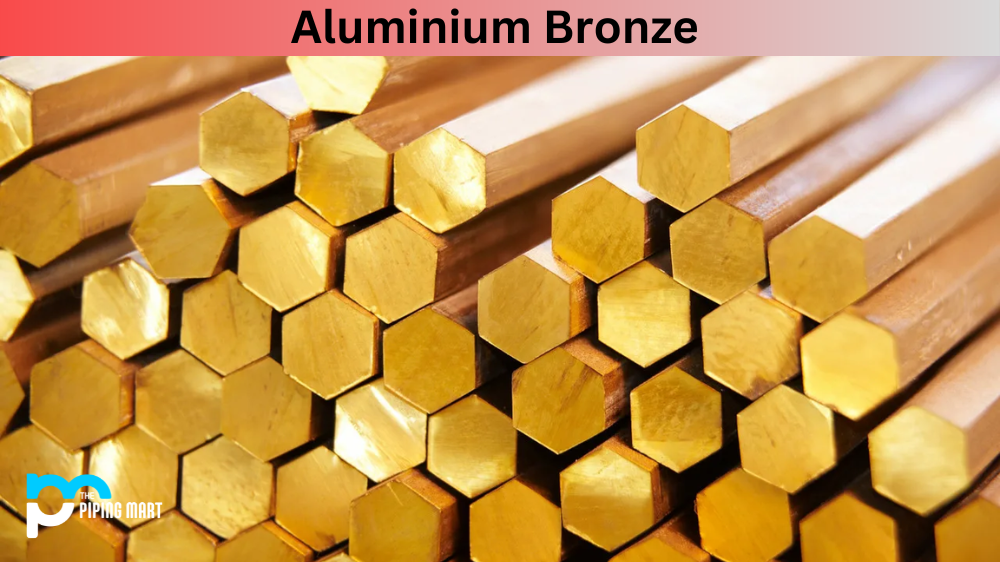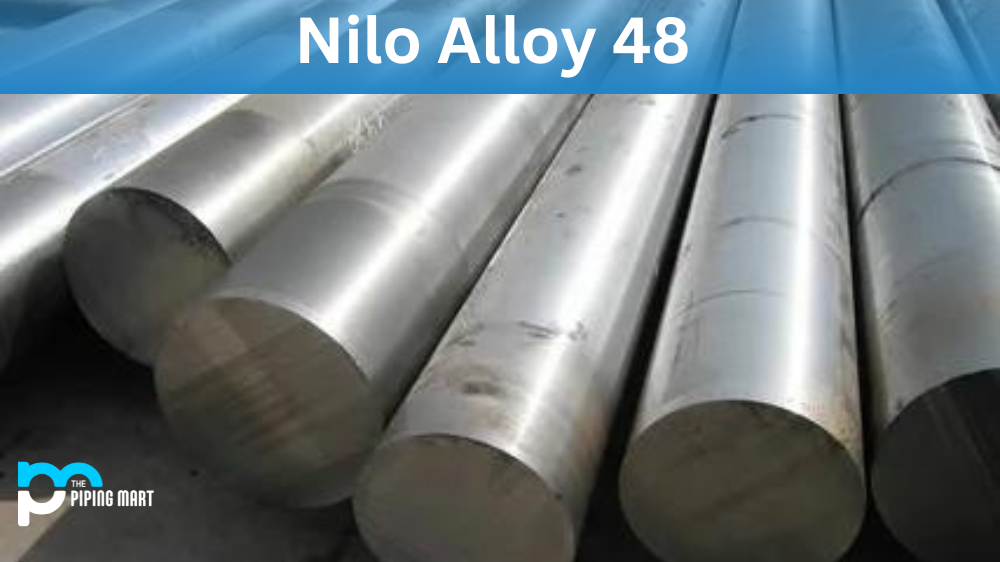Aluminium bronze UNS C95400 is a popular metal alloy that offers a range of benefits over other copper-based alloys. It is known for its excellent mechanical and physical properties, including high strength, corrosion resistance, and heat resistance. Additionally, its unique composition makes it suitable for various marine, aerospace, and chemical processing applications. In this blog post, we’ll look closer at UNS C95400 and explore its composition, properties, uses, heat treatment, machining, welding, and more.
What is Aluminium Bronze UNS C95400?
Aluminum Bronze UNS C95400 is a high-strength alloy composed of copper, aluminium and other alloying elements. It offers superior wear resistance, exceptional mechanical properties, good corrosion resistance and an outstanding strength-to-weight ratio. The alloy is widely used in applications that require wear and corrosion protection and high-strength components.
UNS C95400 Composition
Aluminium bronze, also known as aluminium bronze or high-strength brass, is an alloy of copper, aluminium, iron, and nickel. UNS C95400 has a higher aluminium content (10-11%) than other copper-based alloys, increasing strength, corrosion resistance, and wear resistance. It also contains iron (3-5%) and nickel (3-5%), which improve its tensile strength and toughness.
| Element | Content (%) |
|---|---|
| Cu | 85 |
| Fe | 4 |
| Al | 11 |
UNS C95400 Mechanical Properties
UNS C95400 is a high-strength alloy with excellent mechanical properties, high tensile and yield strength, good ductility, and low friction. Its ultimate tensile strength is around 105 ksi (725 MPa), while its yield strength is about 47 ksi (325 MPa). Its elongation at break is around 10%, which indicates good ductility. Its low friction coefficient, and hardness (around 190 Brinell) make it suitable for bearing applications.
| Properties | Metric | Imperial |
|---|---|---|
| Hardness, Brinell ( as cast; 3000 kg) | 170 | 170 |
| Hardness, Brinell(TQ50 temper; 3000 kg) | 195 | 195 |
| Hardness, Rockwell B (as cast) | 83 | 83 |
| Hardness, Rockwell B (TQ50 temper) | 94 | 94 |
| Tensile strength, ultimate (as cast) | 515 MPa | 74700 psi |
| Tensile strength, ultimate (TQ50 temper) | 620 MPa | 89900 psi |
| Tensile strength, yield ( as cast) | 205 MPa | 29700 psi |
| Tensile strength, yield(TQ50 temper) | 310 MPa | 45000 psi |
| Elongation at break (TQ50 temper, in 50 mm) | 8% | 8% |
| Elongation at break (as cast, in 50 mm) | 12% | 12% |
| Reduction of area (TQ50 temper) | 6% | 6% |
| Reduction of area (as cast) | 12% | 12% |
| Creep strength (for 10E-5%/h, at 425°C) | 20.0 MPa | 2900 psi |
| Creep strength (for 10E-5%/h, at 370°C) | 30.0 MPa | 4350 psi |
| Creep strength (for 10-E5%/h, at 315°C) | 51.0 MPa | 7400 psi |
| Creep strength (for 10E-5%/h, at 230°C) | 115 MPa | 16700 psi |
| Modulus of Elasticity | 110 GPa | 16000 ksi |
| Compressive strength ( as cast) | 940 MPa | 136000 psi |
| Compressive strength (TQ50 temper) | 1070 MPa | 155000 psi |
| Poisson’s ratio | 0.316 | 0.316 |
| Charpy impact (keyhole, TQ50 temper) | 9.00 J | 6.64 ft-lb |
| Charpy impact (keyhole, as cast) | 15.0 J | 11.1 ft-lb |
| Izod impact (TQ50 temper) | 15.0 J | 11.1 ft-lb |
| Izod impact (as cast) | 22.0 J | 16.2 ft-lb |
| Fatigue strength (@# of cycles 1.00e+8 , reverse bending) | 240 MPa | 34800 psi |
| Machinability (UNS C36000 (free-cutting brass) = 100%) | 60% | 60% |
| Shear modulus | 41.0 GPa | 5950 ksi |
UNS C95400 Physical Properties
UNS C95400 has excellent physical properties, including high corrosion resistance in seawater and other aggressive environments, good heat resistance (up to 500°C), and good thermal and electrical conductivity. It also has a low coefficient of thermal expansion, which makes it suitable for applications that require dimensional stability.
| Properties | Metric | Imperial |
|---|---|---|
| Density | 7.45 g/cm3 | 0.269 lb/in3 |
| Melting point | 1025 – 1040°C | 1877 – 1900°F |
UNS C95400 Thermal Properties
| Properties | Metric | Imperial |
|---|---|---|
| CTE, linear (@ 20.0 – 300°C/68.0 – 572°F) | 16.2 μm/m°C | 9.00 μin/in°F |
| Specific heat capacity | 0.420 J/g°C | 0.100 BTU/lb°F |
| Thermal conductivity (@ 20.0°C/68.0°F) | 59.0 W/m-K | 409 BTU-in/hr-ft2 °F |
| Solidus | 1025°C | 1877°F |
| Liquidus | 1040°C | 1900°F |
UNS C95400 Equivalents
- ASME SB148
- ASME SB271
- ASTM B148
- ASTM B271
- ASTM B30
- ASTM B505
- ASTM B763
- ASTM B806
- MIL C-11866
- QQ C390
- SAE J461
- SAE J462
UNS C95400 Uses
UNS C95400 is widely used in marine, aerospace, and chemical processing industries due to its unique properties. It is used for various applications, including marine propellers, bearings, gears, pumps, valve components, bushings, and wear plates. It is also used in the aerospace industry for engine components, landing gear, and hydraulic system parts. Additionally, it is used in the chemical processing industry for pumps, valve bodies, and heat exchangers.
UNS C95400 Corrosion Resistance
UNS C95400 offers excellent corrosion resistance in seawater and other corrosive environments, making it suitable for marine applications. It also has good resistance to stress corrosion cracking and dezincification, which are common problems with other copper-based alloys.
UNS C95400 Heat Treatment
UNS C95400 can be heat treated to improve its mechanical properties by precipitation hardening or annealing. Precipitation hardening involves heating the alloy to a specific temperature range and cooling it rapidly. Annealing involves heating the alloy to a specific temperature and cooling it slowly. A qualified professional should perform the heat treatment process to ensure optimal results.
UNS C95400 Machining
UNS C95400 can be machined using traditional methods such as milling, turning, and drilling, but it requires appropriate cutting tools and feeds to prevent work hardening. The alloy has a high tendency to work hard, which can make it difficult to machine. Therefore, it is recommended to use carbide or diamond cutting tools with high cutting speeds and low feed rates to minimize work hardening.
UNS C95400 Welding
UNS C95400 can be welded using various methods, such as gas tungsten arc welding (GTAW), gas metal arc welding (GMAW), and resistance welding. However, it requires appropriate welding techniques and precautions to prevent cracking and porosity. Using filler metals with a similar composition is also recommended to prevent galvanic corrosion.
Conclusion
Aluminium bronze UNS C95400 is a unique copper-based alloy that offers a range of benefits over other copper-based alloys. Its high strength, corrosion resistance, and heat resistance make it suitable for various applications in the marine, aerospace, and chemical processing industries. Its excellent mechanical and physical properties make it famous for bearing applications. Understanding the alloy’s composition, properties, uses, heat treatment, machining, and welding ensures optimal performance and reliability. If you have any questions or need assistance with UNS C95400, please get in touch with an expert in the field.

Meet Bhavesh, a seasoned blogger with a wealth of knowledge and experience. From metal products manufacturing to retail, Bhavesh has a diverse background in various industries and is dedicated to sharing his insights and expertise with readers.




